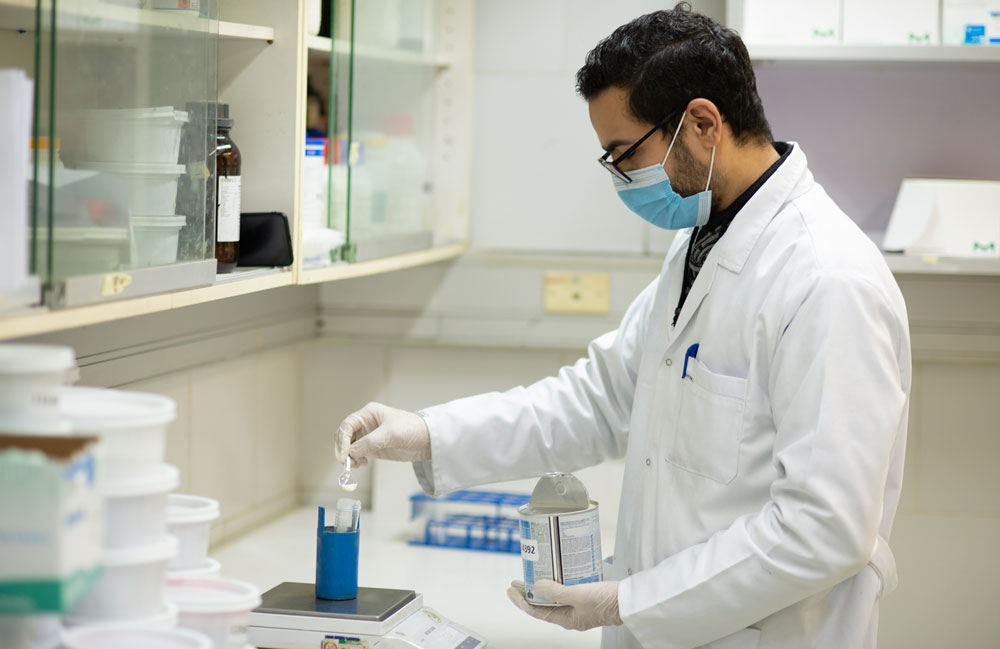Other tests
- Melamine
Dioxin andmelamine are used in huge quantities in the manufacture of plastic materials. However, Melamine has been recently used by traders in the adulteration of children’s milk and dietary supplements, as it provides high levels of protein. The use of melamine and its derivatives cause multiplied health risks such as kidney failure and reduced fertility.
In QCAP lab, Melamine and Cyanuric acid (a derivative of melamine) are assessed within limits which are less than maximum permissible limits of standard international specifications using a LC-MS/MS instrument.
- The list of tests includes:
– Melamine
– Cyanuric acid
The chemical composition of this group of organic compounds is characterized by the presence of both, carbon and hydrogen in the form of connected benzene cycling. They can be divided into groups containing less than four benzene cycling called Light Polycyclic Aromatic Hydrocarbons “Light PAHs” and groups containing more than four benzene cycling Heavy Polycyclic Aromatic Hydrocarbons “Heavy PAHs”.avy PAHs”.
Their Sources
These compounds are spread in the environment as a result of incomplete burning of materials containing carbon, as for example coal, wood, car exhaust and fumes resulting from the burning of waste. Such burning causes the formation of a large group of these compounds, which may be up to 10,000 compounds divided into various groups, water pollution with oils, and petroleum residues. Thus, the human being may be exposed to these dangerous compounds in various ways, either through contaminated food as a result of cooking methods, unhealthy conservation and drying, tobacco and its derivatives, or drinking water environmentally contaminated by these compounds.

-
Health impact and controls over their presence in the diet
Polycyclic Aromatic Hydrocarbons “PAHs” were classified by the European Union Organization as well as the United States Environmental Protection Agency “EPA” as hazardous organic pollutants, because they were proved to cause genotoxicity and cancer.Due to the gravity of these compounds on public health, each of the following organizations:
– The International Program on Chemical Safety “IPCS”
– The Scientific Committee on Food “SCF”
– The Joint FAO/WHO Expert Committee on Food Additives “JECFA”conducted studies about these compounds and investigated their presence in food. Evidence indicated the presence of 16 of such cyclic compounds:
benz[a]anthracene, benzo[b]fluoranthene, benzo[k]fluoranthene, benzo[ghi]perylene, benzo[a]pyrene, chrysene, dibenz[a,h]anthracene, indeno[1,2,3-cd]pyrene, naphthalene, phenanthrene, acenaphythylene, acenaphthene, pyrene, anthracene, flourene, fluoranthene
They issued updates for maximum permissible limits of presence in food and environment in order to minimize and reduce the danger over human health and environment. Until 2006, previous studies and controls were only limited to the investigation of benzo[a]pyrene without paying attention to the danger of the other compounds.
In 2011, the European Union reduced maximum permissible levels to 2 micrograms per kilogram in some food in the report N° 835/2011, including the rest of those pollutants. Studies were pursued and updated till came the report N° 2015/1933 which includes controls over certain kinds of beans, dried food, food of animal origin, as well as fish and smoked food.
Ways of reducing the pollution in PAHs
Pollution of these compounds in food can be reduced by using alternative ways of cooking and food preservation. Studies have proved that the concentration of such compounds has 100% diminished after the use of electric stoves and microwave ovens in cooking as a substitute for coal. Also, the use of different ways of cooking food of animal origin reduces the duration of its exposure to high temperatures for a long time thus preventing the formation of such compounds on the surface. Another way is to develop and reduce time of food preservation by smoking and drying.




